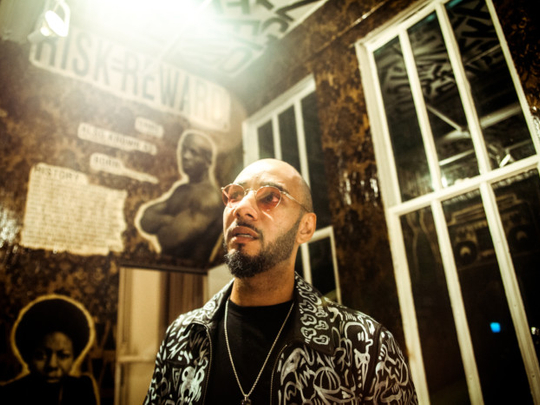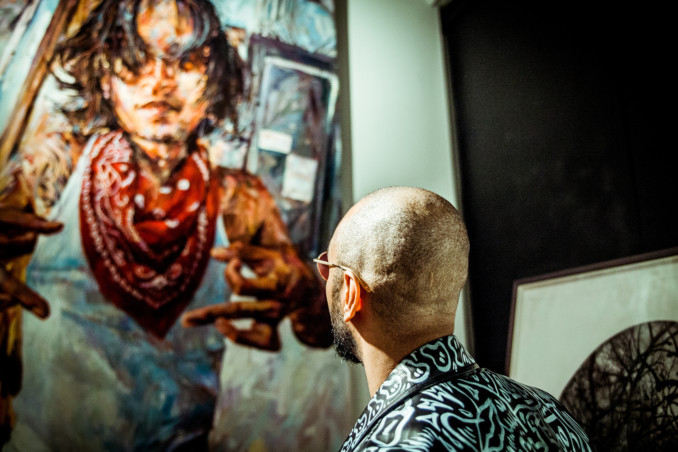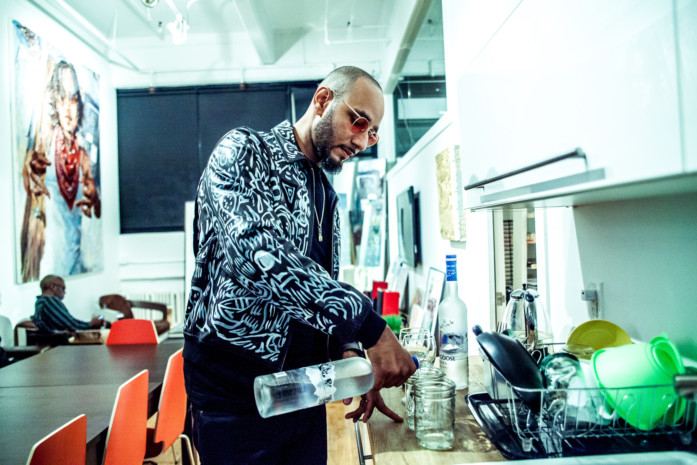
On a recent late-summer evening, a gleaming black Mercedes Maybach pulled up on West 15th Street outside of Kola House, a newly opened restaurant, and lingered quietly by the curb.
In the back seat of the car, amid neon purple light strips, sat Kasseem Dean, aka Swizz Beatz, the hip-hop artist and producer who has worked with the likes of Jay Z, Beyonce and DMX. Kanye West has called him “the best rap producer of all time”.
Dean, 38, is also an avid art collector (and curator for Kola House), who made his first major purchase, an Ansel Adams photograph, when he was 18.
He has since devoted considerable energy to building what he calls the Dean Collection, an assortment of art that he intends to pass on to his five children. It is kept in storage, at home and in his personal studio in Chelsea, which is where the Maybach was headed that evening.
“Sometimes you’re leaving the studio at four, five or six in the morning, you can just lay back and have a little baby moment,” he said, referring to the pillow in his lap from the Brooklyn Museum, whose board Dean joined in 2015.
“My brain doesn’t unlock until midnight,” Dean said. “There’s too much going on in the daytime. I like to make music when the world sleeps. I’m not thinking too much, I’m not checking my phone, the kids are asleep.”
After most studio sessions, Dean heads home to New Jersey to take his children to school and doesn’t fall into bed until 11am. Then, it’s a three- or four-hour nap and back to business.
Beginnings
Dean began working as a disc jockey when he was a teenager, in clubs he wasn’t even old enough to legally enter.
He eventually joined Ruff Ryders Entertainment, a label run by family members, and his career quickly took off.
He was getting paid, but he didn’t trust checks or the concept of fast cash. “I was getting all these checks, and I was putting them in shoeboxes,” Dean said.
Once he realised he actually had several hundred thousand dollars in the bank, Dean bought a house, looked around and realised he didn’t want to decorate with posters. It was time to hit the galleries.
“They wouldn’t take me really seriously,” he said. “I was 18. And the style was different back then: baggy clothes, everything 10 times bigger. I just didn’t look like the type of person who was coming in to buy fine art.”
He eventually met the collector David Rogath, who became his guide to the art world. Dean’s collection now includes works by famed artists like KAWS and Kehinde Wiley.
Support
Back at his music studio, Dean showed off works by Dustin Yellin and Michael Vasquez, then bounded excitedly over to a print of Damien Hirst’s For the Love of God, a platinum skull encrusted with diamonds.
“None of these vibes can hang in my house,” he said, referring to the skull, which appears three-dimensional from certain angles. “Imagine going to the kitchen and that’s in the hallway. Nah, I’m cool.”
In the corner of another room, on the floor next to a set of shelves that displayed photos of Dean and singer Alicia Keys, his wife of six years, were two large plaques. “My wife and friends had these made for my accomplishments throughout the years,” said Dean, who only has a 2010 BET Producer of the Year statuette on display in the studio. “They know I don’t celebrate this type of stuff.”
The support between the pair goes both ways. When Keys was criticised this summer for her decision to go make-up-free, Dean took to his Instagram to defend her choice. “Somebody’s sitting home mad because somebody didn’t wear make-up on their face — not YOUR face, but they didn’t put make-up on THEIR face,” Dean said with incredulity in the post, emphasising that Keys’ decision was a personal one.
After putting the plaques down, Dean walked into the next room, a small recording space. The walls were covered in a brown wash; enlarged newspaper clippings; portraits of rap greats; and sayings like “Get Better.”
Dean appears to share his wife’s interest in authenticity and the natural way of doing things. “I wanted this room to be where you can have a nostalgic feeling,” Dean said. He pointed at an air-conditioning unit, disappointment on his face. “I wanted to leave it out. I wanted it to be hot, so you have to wear tank tops,” he said. “That’s the way it used to be in studios: tank tops, shorts, slippers, making the best music. But it got too hot.”















